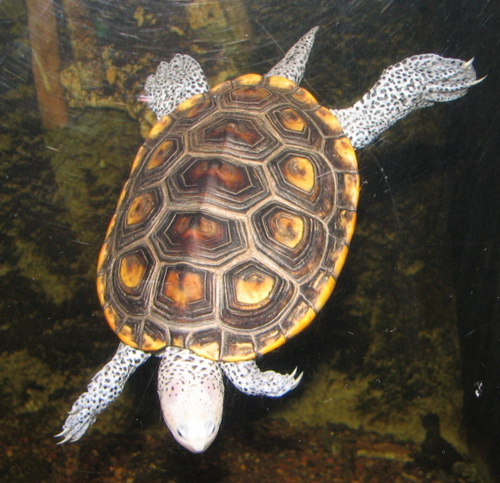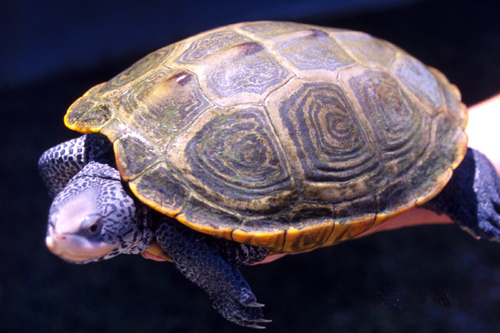The northern diamondback terrapin is medium-sized turtle. Its shell, or carapace, is moderately domed and gray, light brown or black. Each scale on the carapace, or scute, shows distinctive, concentric growth rings. The carapace may be patterned with yellow or orange. The lower shell, or plastron, is yellowish or greenish and does not have any hinges. The turtle's body is whitish or light gray with black speckles. There are white patches along its jaw. The carapace of northern diamondback terrapins measures 4 to 5 1/2 inches for males and 6 to 9 1/2 inches for females.
Northern diamondbacks range along the coast from Cape Cod, Massachusettes south to Cape Hatteras, North Carolina. There are other subspecies; the southern diamondback ranges along the coasts further south. Northern diamondback terrapins are found along the entire Connecticut coastline.
Northern diamondbacks require brackish water. They live in salt marshes, tidal creeks and estuaries.
Eggs are laid in June or July in sandy soil that borders salt marshes. Females migrating from their water home to a nesting site are vulnerable to being run over as they cross roads. Females lay 4 to 18 pink-hued eggs with thin, leathery shells at a depth of 4 to 8 inches. Egg-laying usually occurs at high tide. This prevents the nests from being dug below the tide mark and being inundated with water. Eggs incubate for 9 to 15 weeks. The hatchlings may overwinter in the nest. When they emerge, they head for water.
Diamondbacks can produce 2 clutches a year in more southern climates, but in Connecticut they have only been observed producing 1 annually. The gender of baby diamondbacks is determined by the temperature of the eggs during a particular stage of development. This is common for many turtle species. In an artificial incubation study for diamondbacks, low temperatures produced all males while higher temperatures produced all females. The temperature within a natural nest can vary, so a clutch can produce mixed gender babies.
Northern diamondback terrapin females reach sexual maturity at about 7 years, males do so earlier. Diamondbacks have a lifespan of about 25 to 40 years.
These turtles hibernate for the winter submerged in the mud of tidal creeks. During the warm months they can often be seen basking on mud flats. Turtles cannot regulate their body temperature internally and must warm themselves in the sun.
The diamondback diet includes marine snails, clams and worms. They take in alot of salt through their food and a special gland in the eye excretes the surplus.
In the 1900s these turtles were collected for eating. Their population declined from over-hunting and habitat loss. It is no longer legal to collect diamondbacks for any reason. Their population has rebounded. Sometimes today diamondbacks enter crab pots where they become trapped and drown. They are vulnerable to injuries from motorboats in shallow water and to pollution.

